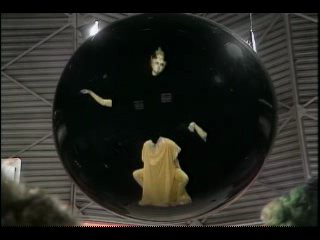 |
| ...and after getting super-old, the Doctor will try to convince people he's an elk... |
1) This is the first serial produced by John Nathan-Turner, who will guide the series until the classic version of the show is put on permanent hiatus in 1990....and boy, does he do whatever he can to differentiate it from the Graham Williams episodes. The new starfield credits, the new music score, the use of 1980's-style (i.e. clunky and primitive) CGI, the darker outfit for the Doctor...everything amounts to Nathan-Turner shouting 'We t'ain't your father's Who!'. And to be fair, the new look does serve to convince us that we've come out of the children's pantomine that the Williams/Adams season had become.
2) ...which isn't to say that the show is without flaws. The serial is so in love with its new CGI-based optical effects department that it devotes big ol' sequences that go on forever to moments that show off their prowess. One shot of a starcraft docking is shown in its entirety roughly four times, and another shot of a model of the titular building on a CGI generated background (complete with too-bright sun beating down) seems to be repeated every time director Lovett Bickford runs out of ideas. And this--along with other moments where Bickford indulges in arty shots like the 360 degree pan of Brighton Beach--slows the pacing of the serial down tremendously.
3) I also wonder if the serial wouldn't have benefited from David Haig not chewing his scenery so vigorously as Pangol. Haig is so sneerily over the top that there's no doubt that he's the villain, and that distracts from the Mafia-manque story that the serial is supposed to be about...and given how Pangol's story arc results in a particularly bad CGI sequence that goes on for so long we can lovingly appreciate the level of crapitude, maybe it's better his story was minimized a bit.
 |
| "Look! CGI! It's DA FUUUUTUUUURE!" |
4) Pangol's craziness also detract from the whole backstory of the Argolins. There are these weird hints at what they're all about and their biology--apparently they're plant beings (it's never explicitly stated) whose age is measured by the number of berries or seed-pods on the top of their head. There's a number of interesting things about Argolin society that is sorta kicked aside for Pangol making nasty references to Greeks, ranting around and overall trying to be Better Than You.
5) I can almost buy the Fomasi. In tight close up they can actually be a bit unnerving. Even when I see them in full figure and notice the big cinch-sack like collar, I can suspend disbelief juuuust enough to let the serial flow on. But I cannot buy the way the villainous Fomasi hide from detection for the bulk of the story....they simply cannot slip into those disguises so easily given their generous form.
6) Here's something that made all of us who weathered the panto silliness of the Graham Williams era happy....this story is based on the admittedly fictitious science of 'tacyonics,' but it's a fictitious science that is both plausible and based on a bit of science fact. Throughout this first season and part of the next, we're going to see some pretty hardcore science fiction concepts--this season ends with a truly amazing story that's tied in to some pretty heady ideas about psychics and mathematics--and it's really refreshing after what we just endured.
 |
| "Raahr! I's a fluffy monsta!" |
8) Thank God that Lalla Ward is wearing something distinct and flattering to her in that Edwardian bathing outfit with the big ol' hat. But then, the costuming overall is very clever in a minimalist way, allowing us to get a sense of each character with only the way a garment falls on them.
9) I rather liked the way the story sees the Doctor transformed (something we'll see again in the very next serial). It shows one of the strengths of the early phase of The Nathan-Turner Years--namely, these serials for the first season and change look for ways to actively challenged and hinder the Doctor. Seeing this doctor struggle with age and his failing brain cells, seeing him express frustration at being slower intellectually is something the viewer hasn't seen before. We'll see this a lot in these early Nathan-Turner tales until the arrival of Script Editor Eric Seward screws it all up.
10) You'll notice how the serial quickly, and pretty much gleefully, disposes of K-9 and the Randomizer within the story. This could be looked upon as Nathan-Turner rushing to convince us that This Is Not Your Father's Who....or if could be the very first indications of Nathan-Turner's pettiness, which we'll see in abundance once he and Seward are a team.
Overall...even with its wonky pacing and weak storytelling choices, this is a decent serial that provides something of a 'mission statement' for this first leg of John Nathan-Turner's era--an era that will sour fairly soon, but right now is bright with promise.
No comments:
Post a Comment